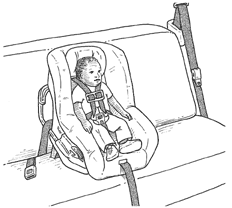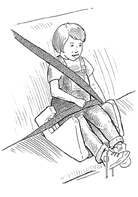 |
|
 |
Always read the child safety seat instruction manual. Each manufacturer provides specific instructions regarding proper use and installation of his/her safety seats.
All children age 12 and under should ride properly restrained in the back seat. Infants MUST NEVER ride rear facing in front seats where a passenger air bag is present!!!!
Face rearward only, recline at a 45o angle, harness slots at or below baby’s shoulders; harness chest clip at armpit level.

 |
When Used Rear Facing:
|
|
When Used Forward Facing:
|
 |
 |
|
|
The Lower Anchors and
Tethers for Children
(LATCH) System is designed to make installation of child safety seats easier by requiring child safety seats to be installed without using the vehicle’s seat belt system. As of September, 1999, all new forward facing child safety seats (not including booster seats) have to meet stricter head protection requirements, which calls for a top tether strap. This adjustable strap is attached to the back of a child safety seat. It has a hook for securing the seat to a tether anchor found either on the rear shelf area of the vehicle or, in the case of mini-vans and station wagons, on the rear floor or the on the back of the rear seat of the vehicle. As of September, 2000, all new cars, minivans, and light trucks will have this tether anchor. |
 |
|
|
By September 1, 2002, two rear seating positions of all cars, minivans and light trucks will come equipped with lower child safety seat anchorage points located between a vehicle’s seat cushion and seat back. Also by September 1, 2002, all child safety seats will have two attachments which will connect to the vehicle’s lower anchorage attachment points. Together, the lower anchors and upper tethers make up the LATCH system. |
|
Used Forward Facing Only
|
 |
Used Forward Facing Only
 |
*A belt-positioning booster seat should be used until the child can sit with his/her back against the vehicle seat back cushion with knees bent over the seat cushion edge, and feet on the floor, approximately 4'9". |  |
Graphics courtesy of: Transportation Safety Training Center, Virginia Commonwealth University